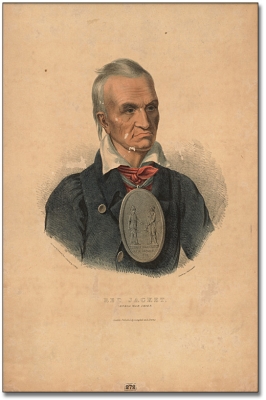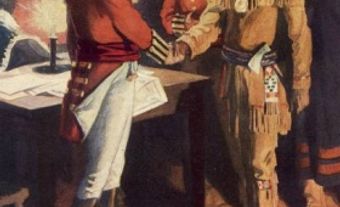Red Jacket (Otetiani), Indigenous leader (born 1750 near Canoga, Seneca County, New York; died 30 January 1830 at Seneca Village, near Buffalo, New York). Otetiani was also known as Red Jacket. This is based on an ornate red officer's coat he received from the British. He received this coat in recognition of wartime service during the American Revolution. He supported the American side during the War of 1812.

Red Jacket
Red Jacket was the son of Thadahwahnyeh (his father) of the Cayuga Turtle Clan. His mother was Ahweyneyonh, a Seneca of the Wolf Clan. In recognition of his oratory skills, he was later called Sagoyewatha (he keeps them awake).
The American Revolution split the Haudenosaunee Confederacy. The Oneida and Tuscarora supported the American colonists. The Kanyen’kehà:ka (Mohawk), Onondaga, Cayuga and Seneca sided with the British. It was during the American Revolution that Red Jacket became a hostile opponent of Joseph Brant. Brant had questioned his courage in battle. Red Jacket had retreated when confronted by General John Sullivan's American troops in 1779. He later attempted to negotiate a separate treaty with the Americans. In the Treaty of Paris (1783), the British ceded the lands between the Appalachian Mountains and the Mississippi River to the United States. However, the British had recognized these lands as sovereign "Indian Territory" with the Quebec Act (1774). Red Jacket did not accept that the British could cede land that belonged to the First Nations. After the Revolution, Red Jacket made efforts to accommodate the new American republic.
He met with George Washington in 1792 and received a "peace medal" from the president. Red Jacket, along with Seneca chiefs Cornplanter (Kaintwakon), Handsome Lake (Ganioda'yo) and Little Beard (Sigwaahdohgwih) negotiated the Treaty of Canandaigua in 1794. This established the conditions for the purchase of lands from the Six Nations south of the Great Lakes.
All members of the Six Nations had agreed to remain neutral with the outbreak of war in 1812. However, the Kanyen’kehà:ka (Mohawk) immediately sided with the British. Red Jacket successfully argued for the Seneca to support the Americans. Although in his sixties, he led the Seneca at the Battles of Fort George and Chippawa. After the war, Red Jacket spent his remaining years in Buffalo, New York.

 Share on Facebook
Share on Facebook Share on X
Share on X Share by Email
Share by Email Share on Google Classroom
Share on Google Classroom


